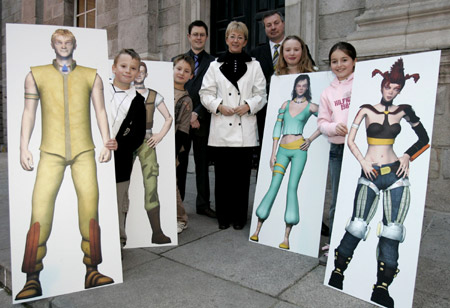TCD-based Telecommunications Research Centre Wins E-Learning Award at Digital Media Awards
Posted on: 07 February 2007
The Resistors! a new animated television series and interactive games on the internet for young people incorporating elements of the science curriculum, which is produced by the Centre for Telecommunications Value Chain Research(CTVR), based in Trinity College, took the top prize for Best E-learning Product as well as a nomination for Best Animation at the recent Digital Media Awards.
The Resistors! uses a blend of a prime-time children’s television series and interactive games and experiments on the web to reinvigorate science education in Irish schools and was developed by one of the Science Foundation Ireland initiative’s flagship projects, The Centre for Telecommunications Value-Chain Research (CTVR) as an outreach programme for Irish schoolchildren.
Speaking at the award ceremony CTVR Director, Professor Donal O’Mahony, said how delighted he was that the jury had selected The Resistors, especially considering the strong field of companies selected as finalists for the Best E-Learning Product 2007 Award.
“This novel approach is a response to the challenge to many Irish science teachers ― how to make science cool and attractive to a generation of school children who maybe glued to a Playstation but don’t necessarily know how it works. With a national commitment to the establishment of a knowledge economy in the next decade today’s schoolchildren will be the engineers and scientists of tomorrow so it is becoming more pressing to encourage them to take science subjects in the Junior and Leaving Certificate cycles,” said Professor O’Mahony.
Commenting on the rationale behind the award winning programme, CTVR’s Director, Professor O’Mahony said: “It has been reported that over 14,000 computer jobs remain unfilled in Ireland because of an ICT skills shortage.The future PhD’s of 2013 are taking their Leaving Certificate this year. If students don’t take higher level mathematics in the Junior Certificate, they have already ruled themselves out of a high level career in the science that CTVR is concerned with. If we can encourage just one extra student in every Junior Cert class to stick with science and maths all the way to third level we can assure the viability of the Irish hi-tech sector and the knowledge economy in the future. We decided that television and the internet were the best way to communicate to children, parents and teachers.”
In order to secure the support of commercial broadcasters CTVR developed a TV series that could stand out in primetime children’s television.
The Resistors, is a CGI-generated cartoon set in Cybernia, a post apocalyptic Ireland of the future. In each 30-minute episode the four young superheroes use their scientific knowledge to defeat evil hackers who have taken over their city.
The main characters correspond to the main areas of the primary science curriculum: Luc (Light), Sonia (sound) Amber (electromagnetism) and Dig (ICT). At the end of each programme the audience are encouraged to go to a specially designed website www.theresistors.com where the respective animated characters explain the science in the programme by a mix of animation, interactive games and fun learning. There is a large emphasis on discovery learning, and users can also download experiments in handy comic style pages to read later.
The organisers hope that the strong role models of the female characters will particularly encourage young girls to consider science as a subject option.
“Because the website will offer many of the mandatory experiments taught on the Junior Certificate curriculum, we hope that teachers will also find this a great way of helping their pupils to learn and understand some of the more tricky science,” said Professor O’Mahony . “In addition, we have web pages devoted to Irish scientists, not only historically, but also highlighting groundbreaking research going on in centres throughout the country today.”
The experiments and teaching materials were developed with secondary science teachers as part of the SFI STAR teacher placement programme.
CTVR chose TG4 to broadcast the show because in addition to primetime slot the station is making its content available as a webcast, which means schoolchildren can view the episodes at any time, either at home or in the classroom. The series will be rebroadcast in the final school term but is available fro free download on the website.
The episodes are also being made freely available in PS2, Gameboy and 3G Mobile phone formats in order to get as much playground take up and exposure as possible. The series was developed by leading educational media company Metadigita Limited and Irish animators Rumble Studios, using an advanced production model for 3D animation and incorporates many models of Dublin landmarks developed at the Interaction, Simulation and Graphics Lab at Trinity College Dublin.
For more information on CTVR and The Resistors click on www.ctvr.ie and www.theresistors.com/press.htm.

